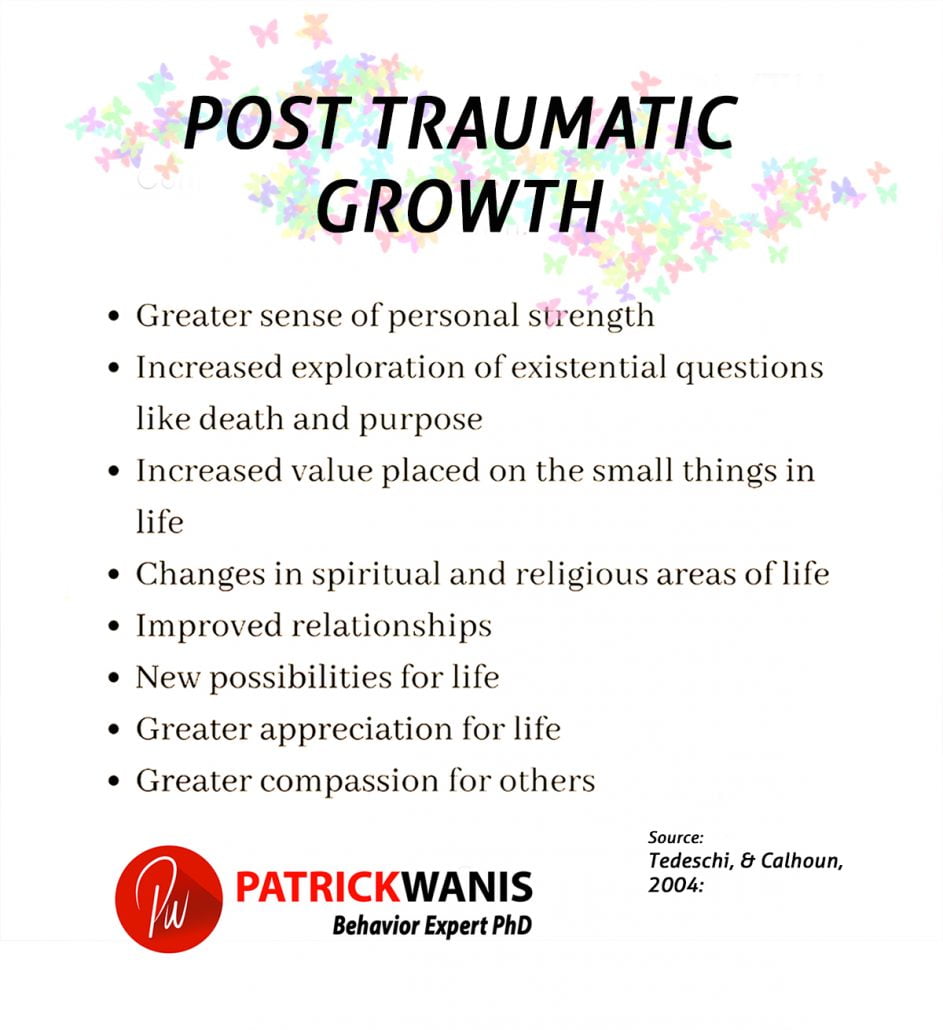First a quick update:
The Breakup Quiz
Are you heartbroken, angry, lost, lonely, confused, depressed, or pining over your ex? How would you like to benefit from personalized advice, action steps and revelations? Take my Free Breakup Quiz and get your own personalized report.
You Can Do It! You Have The Psychological Capital Within You!
Are you struggling to deal with the extreme changes? Are you doubting yourself? Watch the video to learn how to tap into the 4 resources you already possess – Psychological Capital. Watch the video
PTG – Post Traumatic Growth – can you grow from hardship?
Can you transform positively from hardship or a traumatic event?
Of course, you can.
Not everyone will.
But there are pathways to grow from a traumatic experience.
This concept of thriving following hardship is not new. Religion, poetry, philosophy, literature, and other disciplines have taught for centuries that you can grow from pain and suffering. Today, this concept is known in psychology as PTG – Post Traumatic Growth. Contrast this with PTSD – Post Traumatic Stress Disorder whereby one constantly relives the trauma, pain, and suffering.
Before I go any further and reveal the concept of PTG – Post Traumatic Growth, as presented by Lawrence Calhoun and Richard Tedeschi, please read carefully and take note: This concept of transforming positively from hardships, suffering and traumatic events is not a given; it is not an automatic process, and it takes a combination of factors to be realized. The point is, do not diminish or minimize what you experienced nor the loss & pain. And if you experienced trauma in childhood, there is more chance that it weakened you rather than strengthened you. The growth occurs from the struggle with coping not from the trauma itself. Read here about the lifelong impacts of trauma. Trauma is not a good thing, but it is a reality of life, and you can be healed of the trauma and its impact, and you can go beyond healthy living to thriving (an improvement in quality of life.)
“That which does not kill us makes us stronger.”
Friedrich Nietzsche, Translation from the 19th century philosopher’s original German
PTG – Post Traumatic Growth is more than resilience
Resiliency is the ability (and skill) to bounce back from setbacks, disappointments, and failures. My teachings of resiliency include bouncing back with renewed wisdom and motivation. Incidentally, resiliency is formed or enhanced by love and support – not by trauma and hardship. It is social support that helps one to become more resilient to future hardships.

PTG – Post Traumatic Growth means that you have grown in 5 positive ways:
1. Appreciation of life – You shift to acknowledging that time is highly limited, and you can focus on the good in life.
2. Relationships with others – You no longer take people for granted; you awaken to those who are truly important to you; you draw closer to them and express more love.
3. New possibilities in life – Developing new interests, establishing a new path in life, doing better things with one’s life; embracing new opportunities
4. Personal strength – Realization of one’s strength, skills, resources, and resilience
5. Spiritual change – Discovering new meaning in life and seeking to express more love and serve others
“For most trauma survivors, posttraumatic growth and distress will coexist, and the growth emerges from the struggle with coping, not from the trauma itself. Second, trauma is not necessary for growth.”
Posttraumatic Growth: A New Perspective on Psychotraumatology, Richard G. Tedeschi, PhD and Lawrence Calhoun, PhD
A True Story of PTG – Post Traumatic Growth
The best way to illustrate the PTG – Post Traumatic Growth concept is with the story and words of Ric Elias.
Ric Elias had a front-row seat on Flight 1549, the plane that crash-landed in the Hudson River in New York in January 2009. Here is what he shared about his PTG – Post Traumatic Growth two years after his miraculous survival.
Now I want to share with you three things I learned about myself that day.
I learned that it all changes in an instant.
We have this bucket list; we have these things we want to do in life.
And I thought about all the people I wanted to reach out to that I didn’t,
All the fences I wanted to mend,
All the experiences I wanted to have, and I never did.
As I thought about that later on, I came up with a saying, which is, “I collect bad wines.”
Because if the wine is ready and the person is there, I’m opening it.
I no longer want to postpone anything in life.
And that urgency, that purpose, has really changed my life.
The second thing I learned that day,
And this is as we clear the George Washington Bridge,
Which was by not a lot –
I thought about, wow, I really feel one real regret.
I’ve lived a good life.
In my own humanity and mistakes, I’ve tried to get better at everything I tried.
But in my humanity, I also allow my ego to get in.
And I regretted the time I wasted on things that did not matter with people that matter.
And I thought about my relationship with my wife, with my friends, with people.
And after, as I reflected on that, I decided to eliminate negative energy from my life.
It’s not perfect, but it’s a lot better.
I’ve not had a fight with my wife in two years.
It feels great.
I no longer try to be right; I choose to be happy.
The third thing I learned:
And this is as your mental clock starts going, “15, 14, 13.”
You can see the water coming.
I’m saying, “Please blow up.”
I don’t want this thing to break in 20 pieces like you’ve seen in those documentaries.
And as we’re coming down, I had a sense of, wow, dying is not scary.
It’s almost like we’ve been preparing for it our whole lives.
But it was very sad.
I didn’t want to go; I love my life.
And that sadness really framed in one thought, which is, I only wish for one thing.
I only wish I could see my kids grow up.
About a month later, I was at a performance by my daughter – first-grader, not much artistic talent – yet!
And I’m bawling, I’m crying, like a little kid.
And it made all the sense in the world to me.
I realized at that point, by connecting those two dots; that the only thing that matters in my life is being a great dad.
Above all, above all, the only goal I have in life is to be a good dad.
I was given the gift of a miracle; of not dying that day.
I was given another gift, which was to be able to see into the future and come back and live differently!
I challenge you guys that are flying today,
Imagine the same thing happens on your plane –
And please don’t – but imagine, and how would you change?
What would you get done, that you’re waiting to get done because you think you’ll be here forever?
How would you change your relationships, and the negative energy in them?
And more than anything, are you being the best parent you can?
If you would like to release trauma or some other painful event, do it now gently, easily, and quickly with my SRTT process. Book a one-on-one session with me.
You can add to the conversation below.
I wish you the best and remind you “Believe in yourself -You deserve the best!”
Patrick Wanis Ph.D.
Celebrity Life Coach, Human Behavior & Relationship Expert & SRTT Therapist
Anointed “The Woman Expert” by WGN Chicago, Patrick Wanis PhD is a renowned Celebrity Life Coach, Human Behavior & Relationship Expert who developed SRTT therapy (Subconscious Rapid Transformation Technique) and is teaching it to other practitioners. Wanis’ clientele ranges from celebrities and CEOs to housewives and teenagers. CNN, BBC, FOX News, MSNBC & major news outlets worldwide consult Wanis for his expert insights and analysis on sexuality, human behavior and women’s issues. Wanis is the first person ever to do hypnotherapy on national TV – on the Montel Williams show.

